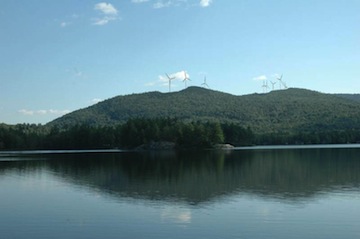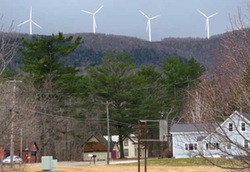UPDATE, 5/31/12: The article in The Australian that spurred this post has triggered a quick back-and-forth in the couple days since it was published. First, this article implied it was nothing more than a renegade staffer speaking without understanding the issue, quoting a Queensland Health spokesman as saying the Department has not issued any new guidance on wind farms, and insisting that a National Health and Medical Research Council (NHMRC) short “rapid review” statement remains the relevant document. But this was quickly followed by a very clear statement from the Chairman of the NHMRC team currently doing a more in-depth study of the issue of health issues near wind farms; the Chair, Bruce Armstrong, affirmed that it’s “entirely appropriate to adopt the precautionary principle where it is neither possible to say with any certainty there is a problem nor is it possible to exclude with any certainty the existence of a problem.” And, a further statement from Queensland Health also endorsed the letter, saying “Our letter to the Tablelands Council was to advise council of the NHMRC guidelines and the fact that these guidelines are being reviewed by NHMRC.”
The author of the original letter, David Sellars, is a Director in the Environmental Health Branch, which deals with “health risk assessments of environmental hazards,” and currently directs the Tropical Regional Services office, which focuses on health of populations, rather than individuals. So, it appears the Mr. Sellars was not operating outside his area of responsibility. It remains unclear whether, as stated in the “Climate Spectator” column that ran the initial “retraction” of the statement, Mr. Sellars well-versed in the state of research on the issue. The second Departmental statement certainly confirms it’s more than his personal opinion.
So, with all that in mind, here’s the bit that triggered such a quick and chaotic response:
Queensland Health has become the first government health agency to recommend a “cautionary” approach to wind farm siting, urging the Tablelands Regional Council to maintain a 2km (1.25 mi) buffer between new wind turbines and residences. Tablelands is considering an application for an 80-turbine wind farm, nine of which are within 2km of homes.
Despite the fact that the proposed Mount Emerald wind farm would meet existing noise criteria, Queensland Health noted that “Research into the potential health effects of wind turbines is ongoing and is being undertaken on an international scale.” A 2km setback would likely nearly eliminate health effects triggered by sleep disruption and greatly reduce stress-related health effects that have been increasingly reported by some residents living near wind farms. Many wind farm neighbors also note physical sensations that they attribute to infrasound and low frequency noise, which would be also be reduced at 2km.
Queensland Health’s director of environmental health, David Sellars, said the National Health and Medical Research Council was reviewing its position on the possible health effects of wind turbines and was aiming to release a public statement by the end of the year. “Queensland Health would be likely to be guided by the NHMRC statement, resulting from this research,” he said. “Until such time, Tablelands Regional Council is encouraged to take a precautionary approach to development applications of this type.”
Mr Sellars noted that the Victorian governments recently adopted planning guidelines, which ban wind turbines within 2km of homes, could be considered current best practice from a cautionary perspective. New South Wales is currently considering similar draft guidelines, and in South Australia, noise levels are limited to 35dB in areas “primarily intended for rural living,” which in effect creates nearly as much setback from homes.
Further update, 5/31/12: The Mayor of Tablelands has said that it’s likely the local council will await the publication of the new, more comprehensive report from the NHMRC before making a decision on local wind farm siting standards. “I think councillors would be very interested to see the outcomes of that before they vote on anything,” said Mayor Rosa Lee Long.
Meanwhile, Ratch Australia, the developers behind the Mt Emerald wind farm proposal, insist there is no rationale for the 2km set-backs enforced elsewhere in the country. “Every site is unique and there is no scientific consideration that justifies the set-back,” the company said in a written statement.
(Ed. note: There is no scientific justification for any common setback standards that govern exactly how far from homes wind turbines can be placed; if it was only about pure science, noise limits would be based on levels that cause physical injury, such as those used in workplace safety laws. Rather, wind farm siting standards are based on local tolerance for noise nuisances, which can never be scientifically determined (though of course we can, over time, get a sense from experience elsewhere to help inform new decisions). 2km standards are generally based on the idea that turbines will only rarely be heard beyond that distance at levels that cause strong annoyance or sleep disruption; the same could be said for other possible distances, since of course topography and atmospheric conditions lead to differences in sound propagation. A reasonable case could be made for any distance from 500m to 3km, depending on how far an ordinance is trying to go toward minimizing the sound level of turbines at homes. 2km is aiming to avoid sound levels loud enough to be intrusive to the more sensitive among local residents, while in most locations, it will not mean turbines are always inaudible.)

 One year-round resident notes that the noise is loudest when his home is downwind of the turbines, and adds, “What is most interesting to me is that they seem loudest on the calmer days. That is, if the wind is barely existent, I can really hear them roaring.”
One year-round resident notes that the noise is loudest when his home is downwind of the turbines, and adds, “What is most interesting to me is that they seem loudest on the calmer days. That is, if the wind is barely existent, I can really hear them roaring.” I guess the third time was the charm for John McCain in his relentless quest to undermine the National Park Service’s decades-long effort to slightly reduce aircraft overflight impacts in the Grand Canyon backcountry. Since the NPS released its draft plan several months ago, McCain had crafted amendments to a couple of pieces of legislation in an effort to codify the status quo overflight rules; this week, it was inserted into the Transportation bill that was passed by the House and Senate and quickly signed by President Obama. The Arizona and Nevada congressional delegations, including Harry Reid, had supported the effort to assure no changes to air tour operations (most air tours are based out of Las Vegas, allowing casino visitors a quick look at the canyon).
I guess the third time was the charm for John McCain in his relentless quest to undermine the National Park Service’s decades-long effort to slightly reduce aircraft overflight impacts in the Grand Canyon backcountry. Since the NPS released its draft plan several months ago, McCain had crafted amendments to a couple of pieces of legislation in an effort to codify the status quo overflight rules; this week, it was inserted into the Transportation bill that was passed by the House and Senate and quickly signed by President Obama. The Arizona and Nevada congressional delegations, including Harry Reid, had supported the effort to assure no changes to air tour operations (most air tours are based out of Las Vegas, allowing casino visitors a quick look at the canyon).
 In addition to three environmental organizations, the Native Village of Chickaloon is party to the lawsuit, saying that NMFS did not fulfill necessary consultation with the tribe, and noting that while the tribe is barred from its traditional hunts due to declining beluga numbers, the permits allow oil and gas development to put whales at risk.
In addition to three environmental organizations, the Native Village of Chickaloon is party to the lawsuit, saying that NMFS did not fulfill necessary consultation with the tribe, and noting that while the tribe is barred from its traditional hunts due to declining beluga numbers, the permits allow oil and gas development to put whales at risk. The Record Hill Wind Farm has made the
The Record Hill Wind Farm has made the